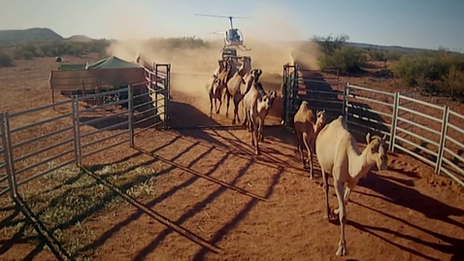Australia, home to the world's largest camel herd
- Published
Simon Reeve Australia - camels
Australia is famous for its wildlife - kangaroos, koalas and numerous species of snakes and spiders - but it is also home to the world's largest herd of camels. There are about 750,000 roaming wild in the outback and they cause a host of problems.
Camels were imported to Australia in the 19th century from Arabia, India and Afghanistan for transport and heavy work in the outback.
But when the internal combustion engine came along and they were no longer needed, several thousand were released into the wild.
With no natural predators and vast sparsely-populated areas in which to roam, the camels have flourished and are having a huge impact on the wilderness.
"One of the biggest problems is that they drink large amounts of water. They gulp down gallons at a time and cause millions of pounds worth of damage to farms and waterholes which are used to water stock. They also drink dry waterholes belonging to the Aborigines," says explorer and writer Simon Reeve.
"Camels are almost uniquely brilliant at surviving the conditions in the outback. Introducing them was short-term genius and long-term disaster."
Lyndee Severin runs a one-million-acre ranch west of Alice Springs in the Northern Territory that has been overrun by the camels.
"They do a lot of damage to infrastructure for us, so there's a lot of damage to fences. They break tanks, they break pumps, they break pipes, they break fences - fences have been our biggest concern," she says.
But her concern is not confined to her own business - the camels put pressure on native Australian species by reducing food sources and destroying their habitats.
"They will just take everything in the landscape and if they destroy the trees and eat the grasses there's no kangaroos, no emus, no small birds if there's no trees, no reptiles," she says.
Severin and her team shoot the beasts, often from helicopters, and leave them to rot where they fall. "It's not something that we enjoy doing, but it's something that we have to do."
Camels roam freely across an area of 3.3 million sq km (1.3 million sq miles) encompassing the states of Western Australia, South Australia and Queensland, as well as the Northern Territory. They are mainly Dromedaries, but some are Bactrian camels.
Humans have introduced dozens of species into Australia - including wild horses, pigs, goats, dogs, cats, rabbits and foxes - and these have now become a major problem for the ecosystem.

Helicopters and modified off-road vehicles are used to round up the camels.
In 2010 the Australian government endorsed a control plan, the Australian Feral Camel Management Project, which aimed to reduce camel densities through culling and mustering the animals for sale.
Between 2001 and 2008 it was estimated there were up to a million feral camels in the outback, but thousands were culled under the project.
Animals Australia, a pressure group, described this as a "bloodbath".
For its part, RSPCA Australia says it would support a national approach to feral camel management, only if "the programmes are clearly explained and justified... and use the most humane methods available".
But many farmers feel that they do not have much choice - and must do what they can with or without a national programme. The economic cost of grazing land loss and damage by feral camels has been estimated at 10m Australian dollars (£6.6m).
"Killing them seems a tragic waste to many of us but the sheer logistics involved mean there is little choice. It is an issue I find more and more as I travel around the world. Humans introduce animals into fragile ecosystems. What do we do about it?" says Reeve, who is presenting a new series on Australia for BBC television.
"It's not enough for us to stand back and say I can't bear to see animals being killed. If we are going to make ourselves gods by meddling with an ecosystem then we have to take the responsibility to sort it out."
Ian Conway, who runs the 1,800 sq km Kings Creek cattle ranch, also near Alice Springs, believes there is a better way of managing their numbers - rounding camels up and selling them for their meat.
Camels range over a vast area and can travel more than 40 miles in a day, so his team uses a helicopter to spot "mobs" of camels. They are then rounded up using heavily-modified off-road vehicles and put into a holding pen, before being sold to the Middle East.
Conway, who has been mustering animals for more than 40 years, says: "There's no difference to camel and beef, in fact to a lot of people who live on camel like we do, prefer it to beef."
Some are also sold as riding camels, he adds.
"The Saudis are always interested in them but they are looking for a specific camel. I've got a bloke who wants beauty camels at the moment. The bulls are no good. They like the cows because of their thin heads, but the cows have got to have their lips hanging, for what reason I don't know," says Conway.
He thinks a round-up is more humane than the alternative.
"They just shoot them and nothing is done with them. We don't know if they lay there for days. I'd like them to come into the yard like this and be sold as meat or riding camels," he says.
In many outback areas it is not cost-effective to round up and sell the camels.
But Conway is convinced that with the right investment this could become a profitable way of protecting ranches and the environment.
Watch Australia with Simon Reeve on BBC2 on 19 May at 21:00 BST or afterwards on BBC iPlayer..